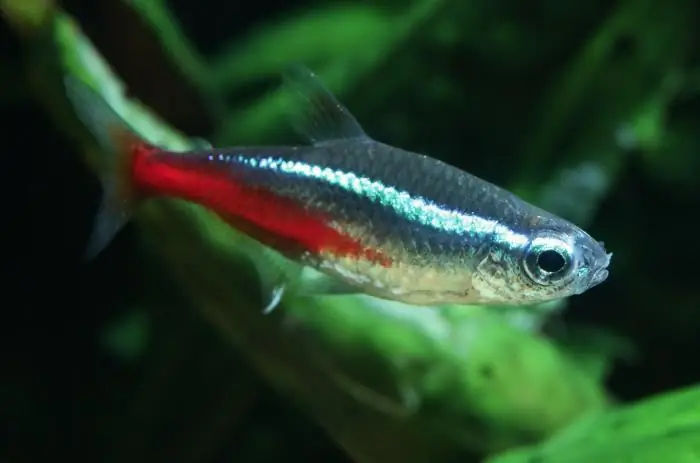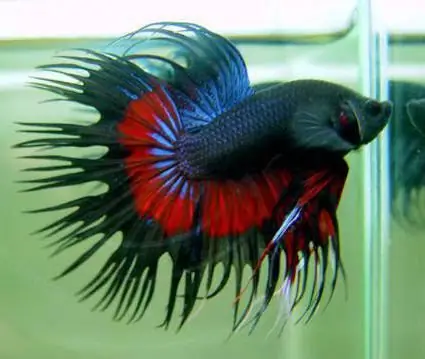2026 Author: Priscilla Miln | [email protected]. Last modified: 2025-01-22 17:55:21
Simple yet attractive, the black phantom aquarium fish has long attracted the attention of aquarists of all ranks and experience. Which is not surprising - it is relatively easy to care for her, she gets sick relatively rarely. And the unusual appearance allows a flock of such fish to become an ornament to any aquarium. Therefore, to learn a little more about it will be useful for any supporter of such a hobby.
Where does the fish come from
The birthplace of the phantom, or black ornathus, is South America. It is there, in the numerous tributaries of the Amazon River, that this amazing fish lives. They usually do not enter the huge and dangerous river itself, preferring to stay in small lakes and streams connected to it.

The habitat covers part of Brazil, as well as some areas of Bolivia. They do not like fast flowing water, preferring lakes or barely flowing streams. Therefore, in the aquarium, even freshly caught fish feel great, without going through a long and difficult acclimatization procedure.
The phantom was first discovered back in 1915. But as an aquarium fish they began to usemuch later - towards the end of the twentieth century.
Appearance
Ornatus black (phantom) cannot boast of significant size. Its length reaches at best 5-5.5 centimeters. The body is quite high and slightly flattened from the sides - a shape characteristic of most fish of the characin family.
At first glance, a high dorsal fin catches the eye. The tail is quite ordinary - two-bladed. The color is dominated by a dark gray tone, sometimes reaching black. Only the belly is lighter. There are black random-shaped spots on the sides - they are surrounded by a thin purple edging, which makes the fish very unusual and attractive. Alas, showing the appearance of a black phantom fish, the photo will not be able to convey all its splendor.

The dorsal and caudal fins are black, while the pectoral and anal fins are transparent, sometimes with dark edging.
At a young age, the fins of some breeds have a reddish tone, which gives them a special beauty.
It was this coloring that caused such an unusual name. With poor lighting, the fish are almost invisible - they merge with the water. But the purple edging of black spots on the backs is visible very well - it seems that only these crescents swim in the aquarium.
How to care
In general, the phantom is black - an aquarium fish is completely unpretentious. Many diseases that pose a mortal danger to other inhabitants of the aqua seem to bypass it. In addition, the phantom adapts very quickly to changing conditions, somoving from one aquarium to another transfers easily, as if not noticing it. Its peaceful nature allows it to be kept with many other fish species. Therefore, it is a good choice for beginner aquarists.
Phantom is a schooling fish. Feels best surrounded by his own kind. So it makes sense to immediately purchase a flock of 5-6, or better - 10-12 individuals.

Perfect for a medium aquarium - from 50 to 100 liters. Taking into account the peculiarities of the reservoirs in which the phantom lives in nature, it is possible not only to densely plant the reservoir with plants, but also to decorate it with snags, shelters made of stones - of course, not forgetting to process everything accordingly. But at the same time, the fish is quite active. Therefore, you should not be too zealous - leave enough space for swimming.
The suitable water temperature range is quite wide - from 20 to 28 degrees. Therefore, they feel great both in summer and in winter. The main thing is not to forget to change the water regularly (about 20% of the total volume per week).
Choosing the right food
In the stern, the black phantom is not too whimsical. He can perfectly manage for many months and even years on dry food - gammarus, daphnia, as well as a mixture enriched with vitamins. But still, if possible, you should often add live or frozen food to his diet - bloodworms, tubifex, brine shrimp and others. In this case, the fish will grow faster, their size will be larger, and their he alth will improve significantly.
In the wild, they also eat somespecies of filamentous algae, small crustaceans, and even fruits that have fallen into the water and begun to rot. Alas, it is simply impossible to completely recreate the natural conditions of life in an aquarium.
How to determine the sex of a fish
But with sex determination, a black phantom can cause serious problems for a novice aquarist. The fact is that at a young age it is almost impossible to distinguish a male from a female. Yes, and in adulthood, you need to take a closer look seriously so as not to be mistaken.

The main difference is the dorsal fin. In males, it is longer, often slightly curved. Females are content with a short fin. But they have a red color in their color - the fins often have just such a shade. And in males, black or dark gray prevails. However, looking closely at a flock of he althy individuals, it will be quite simple to determine where the "boy" and where the "girl" is.
Reproduction
Black phantom breeds in pairs - that is, you need to select one male and one female. It is best to take the strongest, largest and most beautiful. Previously, they are seated in different aquariums - for about a week or 10 days.

Having planted producers in a common aquarium of 7-10 liters, do not expect an immediate result. It will appear in at least two or three days. By this time, the marriage games will begin. The male swims around the female, spreading his fins. The same, responding to courtship, briefly presses her belly against him, throwing out from 8 to 12eggs. This procedure is repeated several times. Young females can sweep away up to 50 eggs, and adults, strong, who have reached the peak of development, up to 150.
Caring for offspring
When the male pours milk on large light amber eggs, adult fish can be transplanted. The aquarium should be darkened and low aeration should be turned on. Don't forget to remove unfertilized eggs first - they will turn white in a few hours, and then begin to decompose and can harm he althy eggs.
After 30-36 hours fry will appear. The best food for them is small rotifers and ciliates. Also be sure to provide them with plenty of algae. Keep cleanliness - although the black phantom perfectly resists diseases, this does not apply to fry. Remove leftover food from the bottom to prevent an epidemic.

By the 10th day you can introduce Artemia nauplii into the diet. Up to 30 days fry should be protected from direct sunlight. At the age of 40 days, they are transplanted into a common aquarium, but make sure that it is sufficiently shaded and contains a large amount of algae in which young growth can hide from other fish. The phantoms themselves usually do not pose a danger to them, but other fish can offend them.
What fish can be kept with
The black phantom has many important advantages. The fish, the maintenance of which is so simple, also gets along well with many other types of aquarium inhabitants. The main thing is to make sure that there are no too aggressive fish among them.
Good luckthe choice will be ternations, neons or minors. Usually phantoms also get along well with zebrafish. To keep order in the aquarium, you can also instill catfish - most of their representatives are not distinguished by aggressiveness or excessive mobility.
Conclusion
Now you know everything you need to know about this breed. You can provide them with proper nutrition and comfortable living conditions. And also easily get he althy, strong offspring.
Recommended:
Haracin aquarium fish: description, maintenance and care

Aquarium characin fish are primarily characterized by their small size and peaceful nature. These flocking underwater inhabitants get along well with almost any neighbors and are easy to care for
Food for cockerel fish: types, choice, norm per day. Cockerel fish: care and maintenance

Cockerel is an amazing fish! Completely unpretentious in care and maintenance, the cockerel has a cool character. How to keep a fish? What kind of feeding does a cockerel require? Who can you match with? Let's figure it out together
Neon fish: care and maintenance. Aquarium neon: fish compatibility

This article aims to introduce readers to one of the most mobile species. So, neon fish. What do we know about her? Unfortunately, not so much. But in vain. This inhabitant of the underwater world is quite interesting, and you can actually talk about it indefinitely
Aquarium fish "black knife": maintenance and care (photo)

Among the huge aquarium diversity, one of the most interesting is the fish known as the “black knife”. Officially, it is called Apteronotus, and in English-speaking countries it is called "black ghost". Experienced aquarists willingly start such exotics in their glass pools. But beginners, perhaps, need to gain experience before venturing into such an acquisition: a black knife is a fish, the content of which requires special attention and skills
Aquarium cockerel fish - maintenance, care and compatibility with other fish

Cockerel fish, or, as it is also called, fighting fish, is a representative of the labyrinth family. Such a name for this species is not accidental. The bright color, as well as the warlike character of the "fighters" in some way resembles the same cocky and beautiful "earthly" roosters

